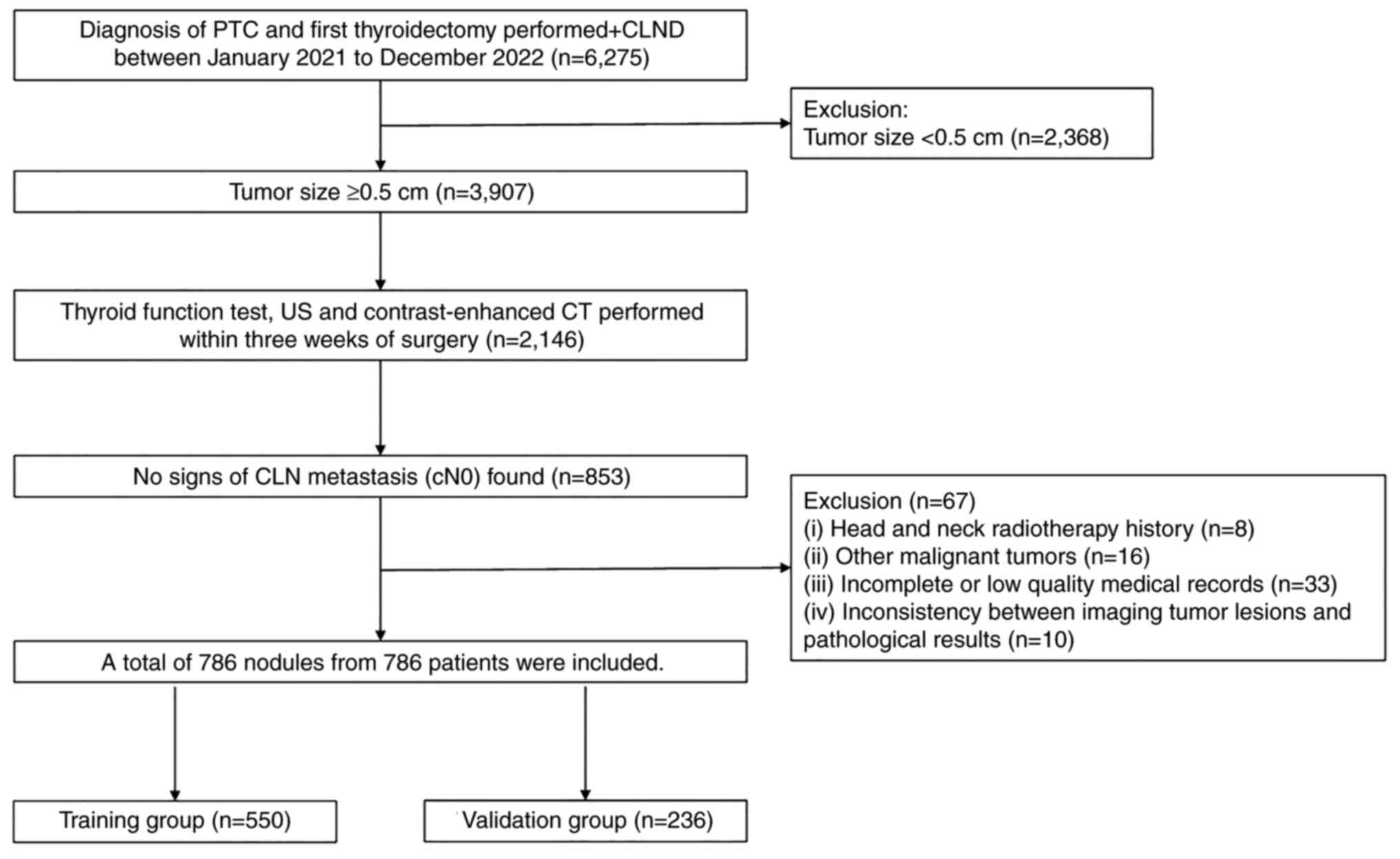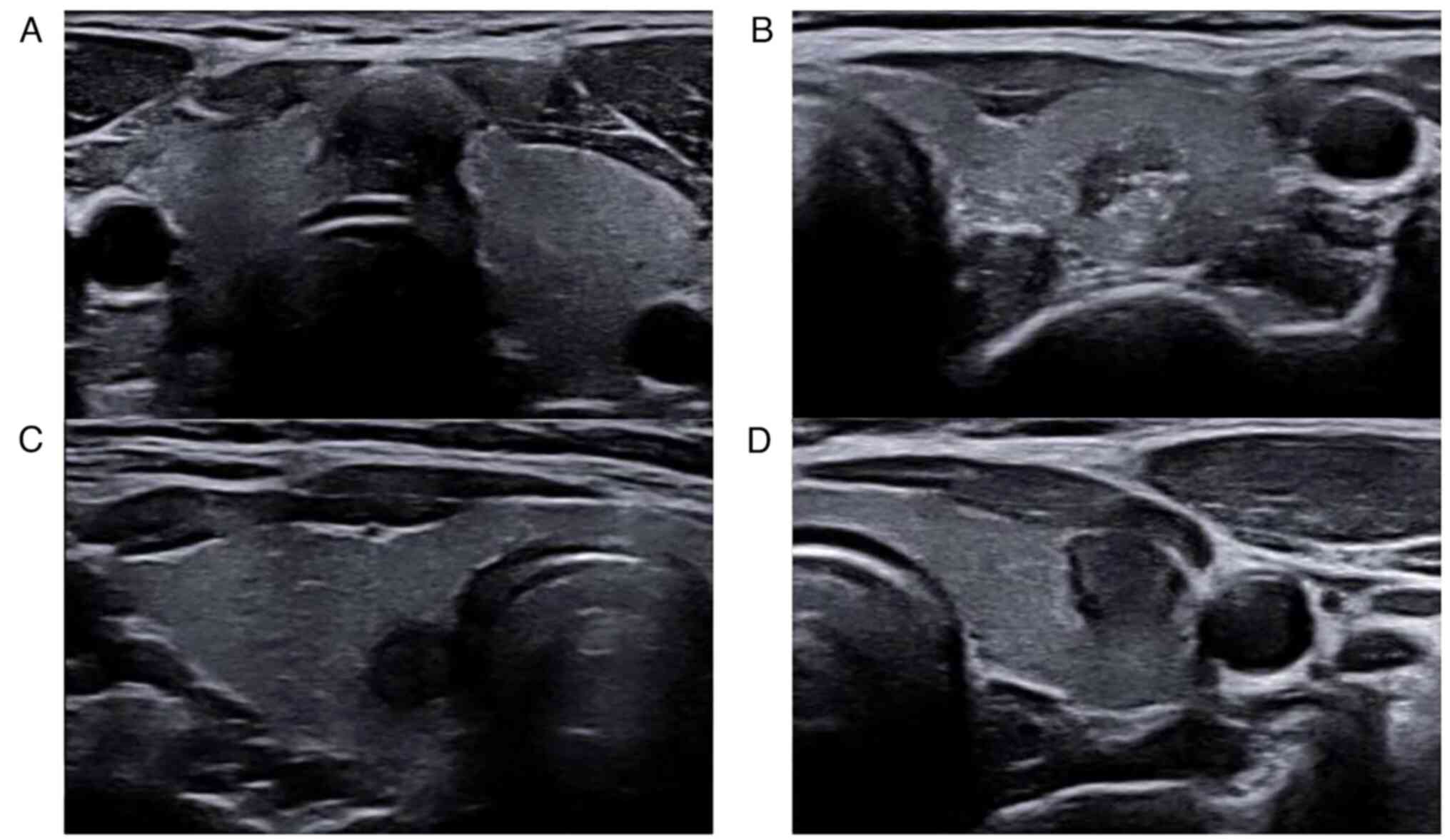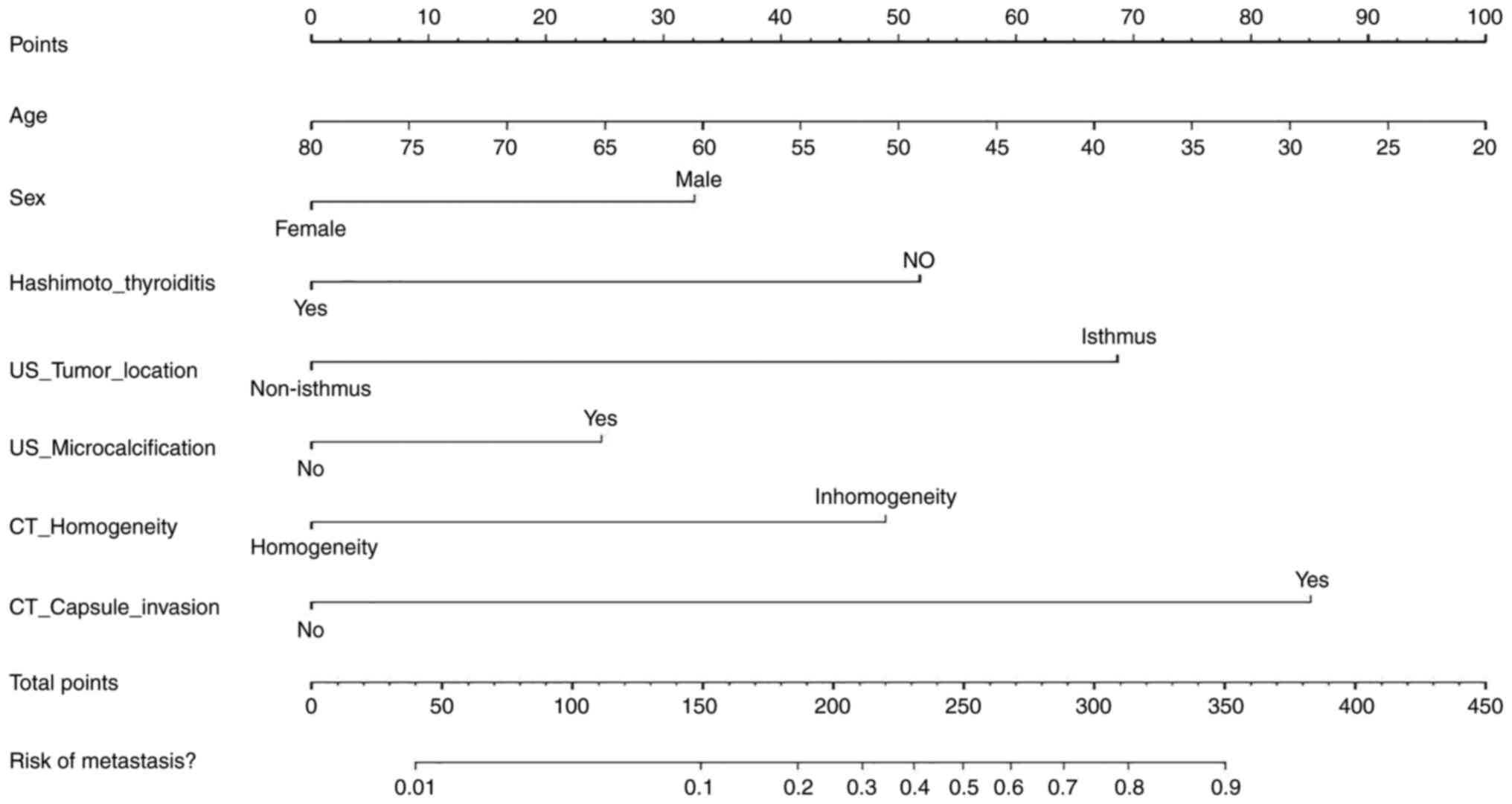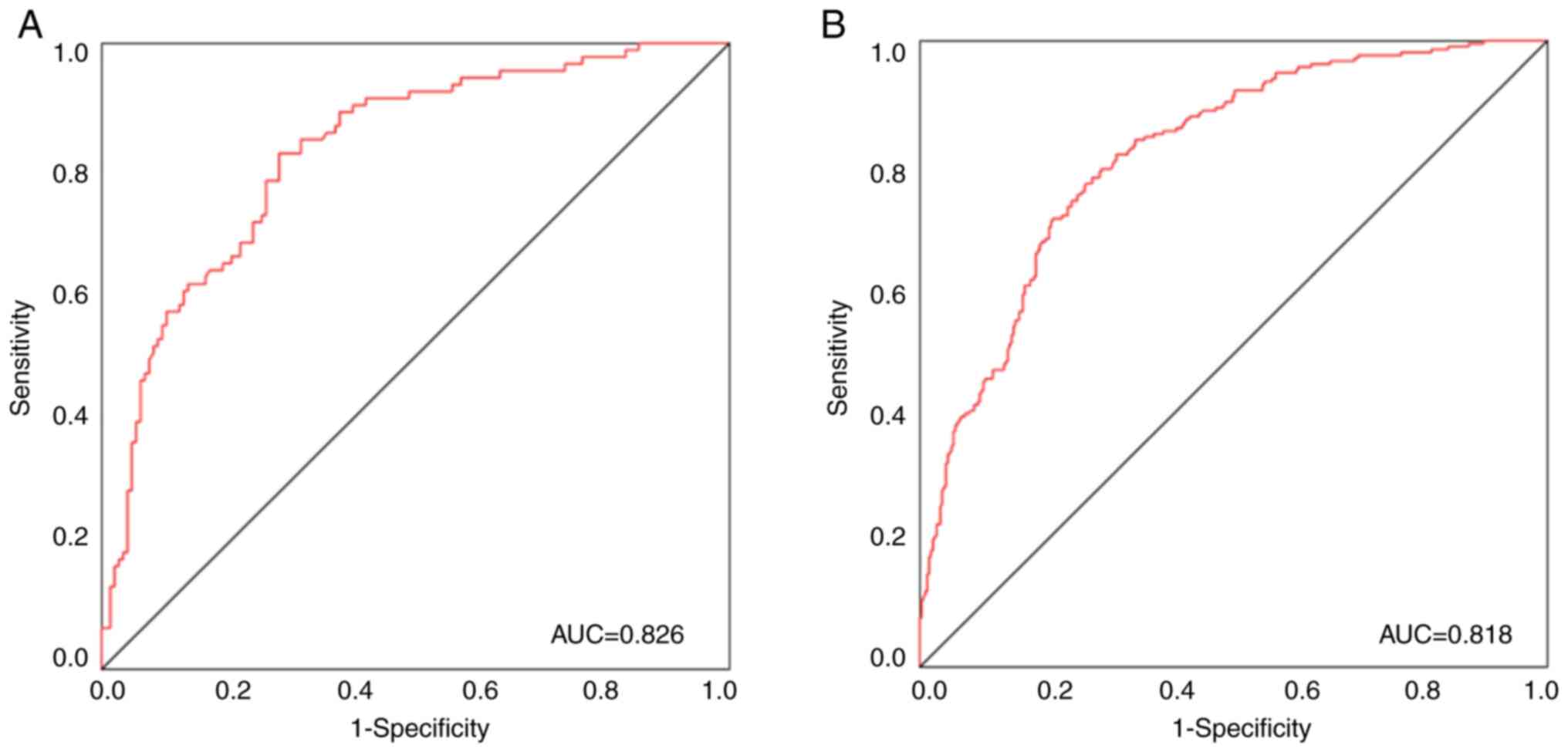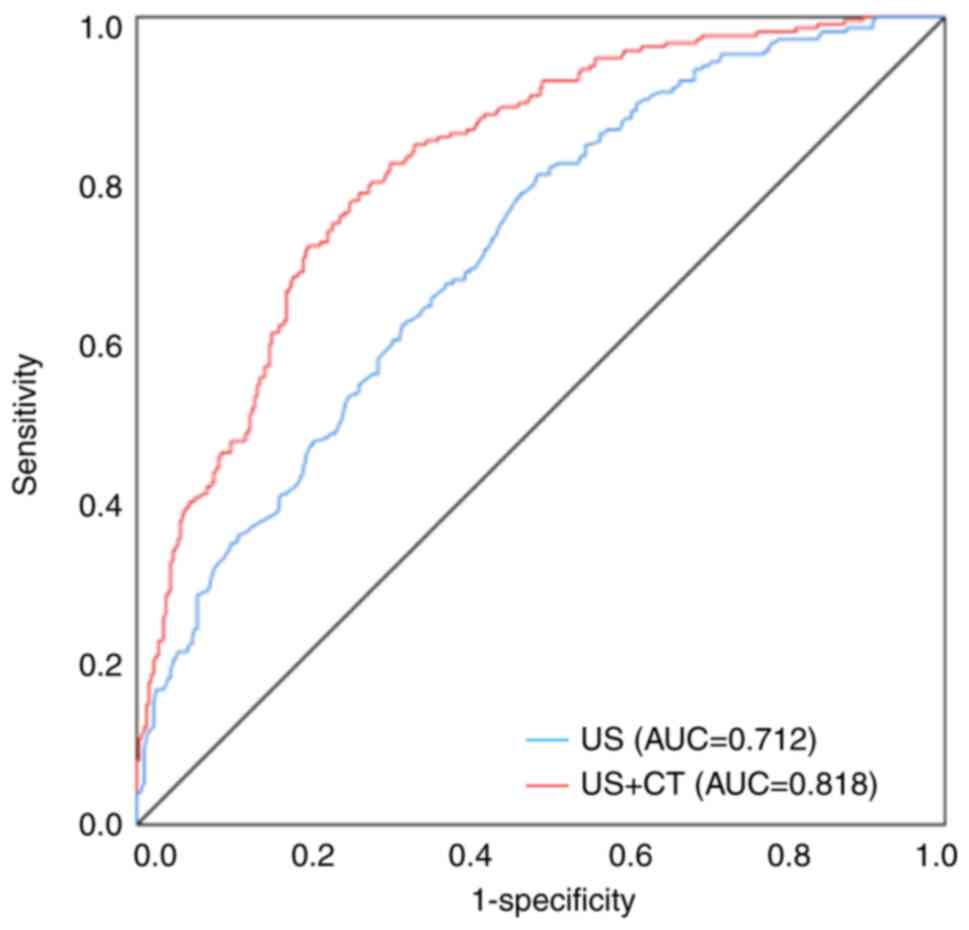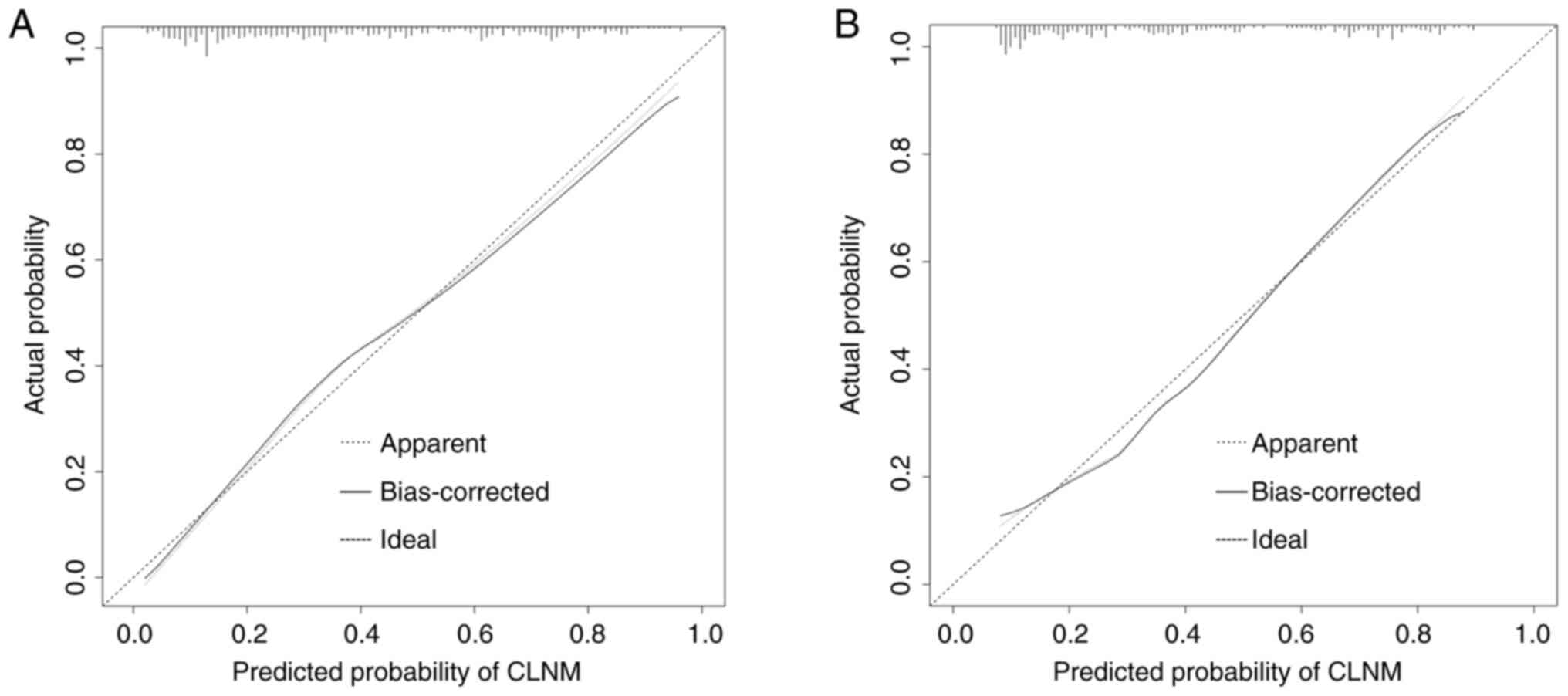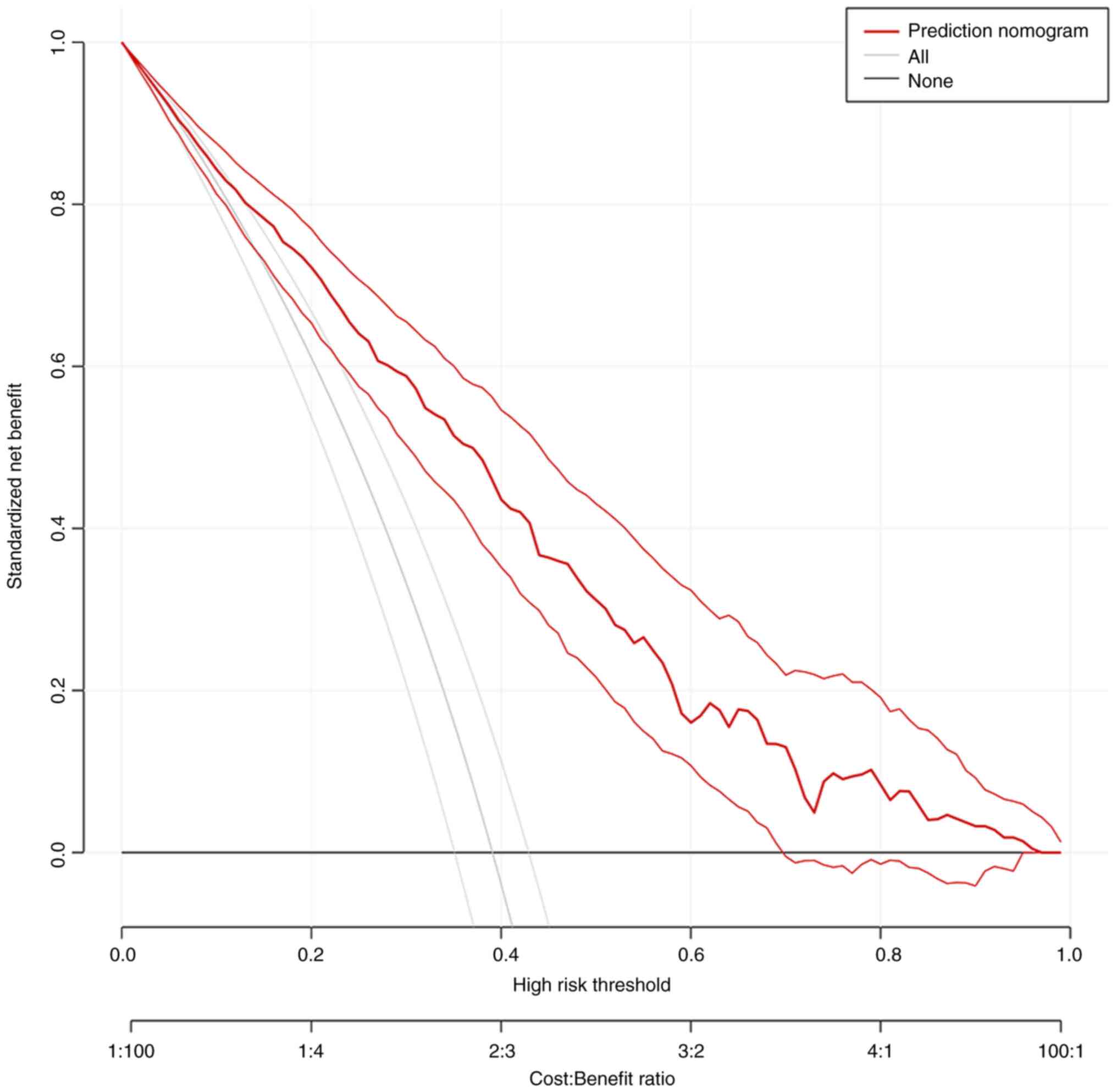Predicting central lymph node metastasis in papillary thyroid cancer: A nomogram based on clinical, ultrasound and contrast‑enhanced computed tomography characteristics
- Authors:
- Published online on: August 5, 2024 https://doi.org/10.3892/ol.2024.14611
- Article Number: 478
-
Copyright: © Zhang et al. This is an open access article distributed under the terms of Creative Commons Attribution License.
Abstract
Introduction
Thyroid cancer, a malignancy ranking ninth worldwide in terms of incidence, can occur in people of any sex and any age (1). Papillary thyroid cancer (PTC) is the predominant type of thyroid cancer, making up ~80% of cases (2). Despite a more favorable overall prognosis compared with other forms of thyroid cancer (3), patients with PTC are more likely to have central lymph node metastasis (CLNM), and the incidence of CLNM is 30–80% (4,5), which is considered to be the most important risk factor of regional recurrence and poor survival (6). Therefore, to achieve the goal of radical tumor resection, surgeons will often perform therapeutic central lymph node dissection (CLND) in patients with PTC (7). However, it is still controversial as to whether CLN dissection should be performed in patients with PTC with clinically negative (cN0) CLNM. Certain cN0 patients have potential CLNM, therefore prophylactic CLND can lower the rate of postoperative regional recurrence rate and avoid a second surgery (8,9). However, prophylactic CLND is not particularly cost-effective, and the risk of recurrent laryngeal nerve injury, permanent hypoparathyroidism and other associated complications is greatly increased (10). Furthermore, ultrasound (US)-guided ablation is a safe, effective and minimally invasive substitute for surgical resection for patients with low-risk PTC without CLNM (11). Therefore, it is important to evaluate the central lymph nodes accurately and comprehensively before operation to avoid overtreatment and undertreatment, and to provide a more reasonable surgical plan for patients.
Given its non-invasiveness, non-radiation and high resolution, US is the preferred preoperative imaging technique for assessing thyroid nodules and cervical lymph nodes. It can clearly show the tumor size, location, shape, margin, composition, echogenicity, microcalcification and blood flow signal (12,13). However, owing to the influence of the anatomical structures of the central neck, the effect of US in detecting CLNM is not ideal (4,14). Meanwhile, US is also limited by the reliance on operator skills and the incapacity to visualize deep structures (15). Therefore, the American Thyroid Association guidelines recommend contrast-enhanced computed tomography (CT) as an adjunct to US to improve the accuracy of preoperative diagnosis (7). Contrast-enhanced CT effectively avoids the shortcomings of US. First, contrast-enhanced CT can provide comprehensive cross-sectional images of the thyroid gland and neighboring structures including the trachea, esophagus, blood vessels and lymph nodes (16,17). Second, due to the absence of gas and bone restrictions, contrast-enhanced CT may better visualize lymph node metastasis, capsule invasion and extrathyroidal extension (18–20).Therefore, the combination of US and contrast-enhanced CT diagnosis would be complementary, to make up for the deficiency of the single application of contrast-enhanced CT or US for diagnosing thyroid nodules, and improve the diagnostic specificity and sensitivity.
Currently, most studies predicting CLNM in patients with PTC have focused on clinical and US features, and the results are consistent (21–23). Furthermore, to the best of our knowledge, few studies have investigated the association between contrast-enhanced CT features and CLNM in patients with PTC. Therefore, the present study used contrast-enhanced CT features to determine the risk factors for CLNM in patients with cN0 PTC, aiming to identify key predictors and establish a new nomogram for predicting the risk of CLNM in patients with PTC to facilitate preoperative decision making for prophylactic CLND.
Materials and methods
Patients selection
Owing to the retrospective study design, approval from the Ethics Committee of Ruijin Hospital, Shanghai Jiao Tong University School of Medicine (Shanghai, China) was obtained and the requirement for informed consent was waived.
A total of 6,275 patients who underwent thyroidectomy along with CLND and were histopathologically confirmed to have PTC at Ruijin Hospital from January 2021 to December 2022 were enrolled in the present study. The inclusion criteria were as follows: i) Treatment with primary thyroid surgery and CLND, and a BRAF V600E mutation test; ii) histopathologically confirmed PTC; iii) no signs of lymph node metastasis (cN0), conventional US and contrast-enhanced CT performed, and a medical history collection within 3 weeks before surgery; iv) preoperative thyroid function tests performed and no prior history of thyroxine treatment [including thyroid stimulating hormone (TSH), thyroglobulin (TG), TG antibody (TGAb) and thyroid peroxidase antibody (TPOAb)]; and v) only the largest nodule was included for patients with multiple nodules (with at least two of which confirmed as PTC). Exclusion criteria were as follows: i) Tumor size of <0.5 cm; ii) treatment of head and neck radiotherapy therapy; iii) presence of other malignant tumors, such as nasopharyngeal carcinoma and breast cancer; iv) incomplete or low quality medical records; and v) inconsistent imaging tumor lesions with the pathological results. Based on the aforementioned inclusion and exclusion criteria, the data from 786 patients with cN0 PTC were analyzed in the present study. The flowchart depicting the selection process is presented in Fig. 1.
US assessment
All participants were evaluated using US equipment (MyLab™ 9, Esaote S.p.A; DC-8, Shenzhen Mindray Bio-Medical Electronics Co., Ltd.; and iU22, Philips Medical Systems B.V.) with 5–13 MHz linear probe. The patient was positioned in the supine position with the neck fully exposed. A total of two radiologists possessing 15 years of experience in thyroid US imaging evaluated the following sonographic features in consensus: Tumor location, size, orientation, margin, internal composition, echogenicity, microcalcification and blood flow signal. Representative US features are presented in Fig. 2. Any disagreements between the two radiologists were resolved by a third radiologist with 25 years of experience in thyroid sonography.
BRAF V600E mutation testing
BRAF V600E mutation testing was performed and the results were reviewed by experienced technicians in the clinical laboratory of Ruijin Hospital. Genomic DNA was extracted from the thyroid tissue samples using QIAamp® DNA Micro Kit (Qiagen, Inc.; cat. no. 56304) according to the instructions. The extracted DNA was subjected to PCR amplification (reagents: Ampli Taq Gold™ 360 Premix of Applied Biosystems; Thermo Fisher Scientific, Inc.; thermocycling conditions: 95°C for 3 min, 95°C 15 sec, 58°C 30 sec, 72°C 1 min, 72°C 7 min, 35 cycles in total) and Sanger sequencing, and the sequencing data were interpreted using the low-frequency mutation analysis software Minor Variant Finder of Applied Biosystems (version 1.1; Thermo Fisher Scientific, Inc.). The sequencing primers used for BRAF V600E mutation testing are provided in Fig. S1. Sequencing traces for Sanger sequencing are shown in Fig. S2.
Contrast-enhanced CT assessment
All patients underwent scanning using multidetector CT scanners (GE Discovery CT750 HD 64 Slice CT Scanner, Cytiva; uCT 760; Shanghai United Imaging Healthcare Co., Ltd; and Philips Brilliance iCT 256, Philips Medical Systems B.V.) to collect CT data. All patients provided written informed consent and underwent iodine allergy testing before the examination. The slice thickness was 3.0 or 2.5 mm. Contrast-enhanced scans were performed at 45–65 sec after intravenous injection of non-ionic iodine contrast agent (2.5 m/s). The scanning range was scanned from C7 up to the base of the posterior fossa. The CT findings of the following nodules were evaluated by two radiologists with extensive experience in thyroid CT imaging: i) Mean CT values of the lesions in the plain phase (UCT) and the venous phase (VCT). A circular region of interest was drawn at the maximum diameter of the lesion, excluding calcification, cystic components and artifacts, with the goal of covering >80% of the whole lesion area. ΔCT=VCT-UCT was used to evaluate the absolute enhanced CT value. The average value of two radiologists was used for further analysis; ii) homogeneity of enhancement was divided into homogeneity and inhomogeneity (Fig. 3A); iii) calcification (Fig. 3B); iv) capsule invasion (Fig. 3C); and v) tracheal deviation (Fig. 3D).
Variable definition and evaluation
Data for the following characteristics were collected to construct a retrospective database: i) Basic features: Age (45 years old as the cut point in accordance with the 7th Union for International Cancer Control/American Joint Committee on Cancer tumor-node-metastasis staging system) (24), sex (male/female), body mass index [BMI; 20.92 kg/m2 as the cut point according to receiver operating characteristic (ROC) curve analysis], Hashimoto thyroiditis (HT; yes/no), BRAF V600E mutation (yes/no), TSH (reference, 0.35–4.94 µIU/ml), TG (reference, 3.5–77 ng/ml), TGAb (reference, <4.11) IU/ml) and TPOAb (reference, <5.61 IU/ml); ii) conventional US features: Tumor location (isthmus/non-isthmus), tumor number (unifocal/multifocal), tumor size (papillary thyroid microcarcinoma ≤1.0 cm and PTC >1.0 cm), tumor orientation (taller-than-wide/wider-than-tall), tumor margin (regular/irregular), internal composition (solid/non-solid), echogenicity (markedly hypoechoic/hypoechoic/isoechoic), capsule contact (yes/no; defined as thyroid nodule touching the thyroid boundary with or without capsule uplift), microcalcification (yes/no) and blood flow signal (poor/rich)' and iii) contrast-enhanced CT features: UCT, VCT, ΔCT, homogeneity of enhancement (homogeneity/inhomogeneity; defined as the degree of homogeneity of enhancement within the thyroid nodule), calcification (yes/no), capsule invasion (yes/no; defined as the maximum diameter of the nodule was located at the junction of the nodule and thyroid gland or at the lateral side of the thyroid gland, known as ‘cookie bite sign’) and tracheal deviation (yes/no). ROC curve analysis revealed that the UCT value was 65.35 Hu, the VCT value was 183.90 Hu, and ΔCT was 111.50 Hu as the cut-off point of CLNM in the population of the present study (data not presented).
Statistical analysis
Continuous data were transformed into categorical data using cut-off values established through ROC curve analysis for enhanced clinical comprehension. Data are presented as the frequency or mean ± standard deviation. UCT, VCT and ΔCT were analyzed using an independent samples t-test, and TSH and echogenicity were analyzed using Fisher's exact test. All other variables were analyzed using the χ2 test. Multivariate logistic regression analysis was used to determine independent factors. Based on the results of multivariate logistic regression analysis, a nomogram for predicting CLNM was developed and evaluated using ROC curves, calibration curves and decision curve analysis (DCA) curves. All statistical analyses were performed using SPSS version 27.0 (IBM Corp.) and R version 4.3.2 (The R Foundation) software. P<0.05 was considered to indicate a statistically significant difference.
Results
Characteristics of patients
Patients were divided into the training group (n=550) and validation group (n=236). CLNM occurred in 39.1% (215/550) of the patients in the training group and 38.6% (91/236) of the patients in the validation group. In total, 38.9% of patients (306/786) had an CLNM(−) status before surgery, but had confirmed CLNM using postoperative pathology. As demonstrated in Table I, there was no significant difference between the two groups (P>0.05), which indicated their rationality as training and validation groups.
Univariate analysis of CLNM
In the univariate analysis, CLNM was significantly associated with a younger age (≤45 years; P<0.001), the male sex (P<0.001), no HT (P=0.001), negative TGAb (P=0.004) and negative TPOAb (P=0.002). However, there were no significant differences for BMI, presence of BRAF V600E mutation, level of TSH or level of TG.
Among the US features, tumor location (isthmus; P<0.001), tumor size (>1.0 cm; P<0.001), presence of microcalcification (P<0.001) and capsule contact (yes; P<0.001) were significantly different between CLNM and non-CLNM groups. However, there was no significant difference for tumor number, tumor shape, tumor margin, internal composition, echogenicity or blood flow signal.
In terms of contrast-enhanced CT characteristics, there were significant differences for an inhomogeneous enhancement (P=0.002), presence of calcification (P=0.007) and capsule invasion (P<0.001), but there were no significant differences for UCT, VCT, ΔCT or tracheal deviation between the two groups (Table II).
Multivariate logistic regression analysis of CLNM
The characteristics with statistical significance identified in the univariate analysis were further analyzed using multivariate logistic regression analysis. The results demonstrated that the following predictors were significantly independently associated with promoting CLNM in patients with PTC: Age of ≤45 years old [odds ratio (OR)=0.964; 95% confidence interval (CI), 0.945–0.982; P<0.001], male sex (OR=2.147; 95% CI, 1.332–3.459; P=0.002), no HT (OR=2.515; 95% CI, 1.208–5.239; P=0.014), isthmic tumor (OR=0.211; 95% CI, 0.067–0.669; P=0.008), presence of microcalcification (OR=0.589; 95% CI, 0.355–0.979; P=0.041), inhomogeneous enhancement (OR=2.711; 95% CI, 0.355–0.979; P=0.041). 95%CI 1.268–5.798, P=0.010) and capsule invasion (OR=6.463; 95% CI, 4.103–10.181; P<0.001; Table III).
Development and validation of the individualized prediction nomogram
According to the results of multivariate logistic regression analysis, 7 variables including age, sex, presence of HT, tumor location, microcalcification, homogeneity of enhancement and capsule invasion were used in the development of a personalized prediction nomogram for predicting CLNM in patients with PTC (Fig. 4). According to the ROC curve, the area under the curve (AUC) was 0.826, the sensitivity was 0.824 and the specificity was 0.717 for the training group, whilst the AUC was 0.818, the sensitivity was 0.725 and the specificity was 0.781 for the validation group (Fig. 5A and B). In addition, the AUC for predicting CLNM without combined contrast-enhanced CT was 0.712, and the AUC of predicting CLNM increased to 0.818 when clinical and conventional US and contrast-enhanced CT features were combined (Fig. 6). This further demonstrates the advantage of the US combined CT model.
Furthermore, calibration curves depicting the CLNM risk nomogram in patients with PTC were generated to assess the effectiveness of the nomogram. The curves indicated a satisfactory agreement in both the training and validation groups, with mean absolute errors of 0.021 (Fig. 7A) and 0.023 (Fig. 7B), respectively.
Clinical application
Finally, DCA was performed to evaluate the performance of the model in detecting CLNM for patients with PTC (Fig. 8). The DCA curve demonstrated that it would be beneficial to predict CLNM with the nomogram when the threshold probability ranges from 0.1 to 1.0.
Discussion
Most PTCs show a slow and indolent growth pattern, and the overall prognosis is favorable, with a current 5-year survival rate of >90% (25). CLNM is occurs in 12–64% of patients with PTC, and exhibits a strong association with increased recurrence and poor overall survival (26). Therefore, precise preoperative prediction of CLNM can be advantageous for patients with PTC (cN0), and creating an effective prediction model would serve as a viable solution. Previous studies have reported that US features of PTC can help predict CLNM in patients, but few of them mentioned the role of CT in this (27–29). In the present study, the US and CT features of patients with PTC were reviewed and the value of US combined with contrast-enhanced CT for predicting CLNM was evaluated.
Many studies have reported that sex and age are independent risk factors for CLNM in PTC, among which the male sex and a younger age (≤45 years) have a greater risk of CLNM (30–32). This is consistent with the findings obtained in the present study. However, the multifocality and tumor size characteristics did not differ significantly between the two groups in the present study, which is not consistent with previous studies (22,31,33). The potential reasons contributing to this variation may be the different sample sizes and evaluation criteria used for characteristics.
HT is the most common autoimmune thyroid disease and 10–58% of patients with PTC have it (34). In most studies, HT has been regarded as a protective factor for CLNM in PTC (35,36), and Jara et al (37) also noted that HT correlated with less aggressive disease and a reduced incidence of lymph node metastasis. Moreover, the present study also demonstrated that patients with PTC but without coexistent HT were more prone to CLNM. However, Mao et al (38) and Liu et al (39) suggested that HT had no significant effect on the incidence of lymph node metastasis. Therefore, the effect of HT on CLNM in PTC is uncertain, and more clinical trials emphasizing the influence of HT on the progression of PTC are worth performing.
To the best of our knowledge, the relationship between PTC tumor location and lymph node metastasis is controversial. Certain studies reported that there is no significant association between tumor location and CLNM (22,40). However, Li et al (41) and Lyu et al (42) suggested that isthmic tumors are more prone to CLNM compared with lateral lobe tumors. The present study also demonstrated that tumor location in the isthmus was significantly associated with CLNM. The thyroid isthmus is typically situated anteriorly to the cartilaginous ring of the second to fourth trachea, where the gland thins to a thickness of only ~2 mm. Due to the specific location of the tumor, the isthmus tumor is adjacent to the trachea and thyroid capsule, so the incidence of extrathyroidal extension, CLNM and multifocality is higher than that of thyroid lobe tumor (43). In addition, the lymphatic drainage pattern of the thyroid isthmus differs from that of the thyroid lobe (41). The presence of the aforementioned features will increase the risk of CLNM in in isthmic tumors (42). Notably, although patients with isthmic tumors were demonstrated to have a higher risk of CLNM, the incidence of this feature was low, accounting for only 4.0% (22/550) of the total cases in the present study.
US is known to provide a better soft tissue resolution than CT, and microcalcifications seen by US are not necessarily shown on CT (44,45). Therefore, in the present study, microcalcifications were evaluated by US, whilst calcifications evaluated by CT were generally macrocalcifications. The present study confirmed that the presence of microcalcification was an independent predictor of CLNM in cN0 PTC and that macrocalcification was not significantly associated with CLNM. Previous studies have also reported an association between microcalcification and CLNM in PTC (46–48). Microcalcifications are characterized as punctate bright echoes with or without accompanying acoustic shadowing, mainly small psammoma bodies of 10–100 µm, arranged in concentric layers (49). Therefore, as microcalcification may be a predictive marker for CLNM (50), when microcalcification is found in thyroid nodules by preoperative examination, a more meticulous evaluation of the central cervical lymph nodes is warranted.
Angiogenesis is known to be associated with aggressive tumor growth and metastasis (51). Contrast-enhanced CT provides improved visualization of the tumor microvascular distribution (33). There were a large number of neovascularization in the thyroid tumor tissue, which appeared to be enhanced after enhancement. However, at the same time, this malignant growth will destroy a lot of tissue structures and blood vessels, so the degree of enhancement is lower than that of normal thyroid (52). Furthermore, heterogeneous vascular distribution can lead to inhomogeneous enhancement shown on contrast-enhanced CT images. The present study demonstrated that although the incidence of inhomogeneous enhancement was relatively high, it was also significantly associated with predicting CLNM.
Capsule invasion is generally regarded as being associated with CLNM. However, whether US or contrast-enhanced CT is superior in predicting capsule invasion is still controversial (19). Yang et al (23) reported that observation of the anterior thyroid capsule by US is influenced by US near-field artifacts, whilst observation of the lateral and posterior thyroid capsules is hindered by the presence of blood vessels and the trachea, which may not be distinctly depicted (8). In addition, considering the strong dependence of US on the operator (15), the present study included capsule contact on US images and capsule invasion on CT images, which were associated but not consistent. The present study demonstrated that capsule invasion assessed by CT is an independent risk factor for CLNM, and its mechanism may be linked to the abundant thyroid lymphatic network. If the tumor breaks through the capsule, it has the potential to readily induce lymph node metastasis in the central region (8,53).
Few studies have investigated the relationship between contrast-enhanced CT features and CLNM. For example, Peng et al (54) and Mou et al (55) collected data from preoperative CT images to predict CLNM in patients with cN0 PTC, but the studies only had small sample sizes. Moreover, Zhao et al (33) used a simple risk-scoring system to predict CLNM. To the best of our knowledge, the present study was the first with an adequate sample size to construct a nomogram combining US with contrast-enhanced CT for predicting CLNM.
Nonetheless, there were several limitations of the present study that should be acknowledged. First, the study design was retrospective, making it susceptible to inherent bias in patient recruitment and data collection. Second, the retrospective nature of the present study may limit the analysis of additional potential variables. Analyses were performed only on the basis of the characteristics of the primary tumor. Furthermore, the present study lacks external validation. Therefore, it is imperative to prioritize additional external validation cohorts from prospective studies to comprehensively assess the viability of the nomogram in the present study. In addition, for multifocal tumors, analysis was performed only on the largest tumor, and the features of the remaining tumors were unknown. Notably, the present study did not assess patients with PTCs that were <0.5 cm.
Despite the limitations, the present study presents certain highlights. Based on the aforementioned clinical, US and contrast-enhanced CT characteristics, the present study developed and validated a novel nomogram, which has an improved diagnostic performance in predicting CLNM than no combination of contrast-enhanced CT. Moreover, the nomogram serves as a user-friendly diagnostic tool for predicting CLNM. By adding the specific scores of each predictor, the corresponding CLNM probability for thyroid nodules can be obtained. Overall, this prediction model could make it possible to personalize the CLNM prediction of most patients with PTC and help surgeons make decisions on surgical options to maximize the benefits of patients.
In conclusion, the findings of the present study suggest that a young age, the male sex, no presence of HT, isthmic tumor, microcalcification, inhomogeneous enhancement and capsule invasion are significantly associated with CLNM in patients with cN0 PTC. Furthermore, the constructed nomogram has the potential to be used for preoperative risk assessment of CLNM, which can help surgeons better develop appropriate surgical plans, providing a novel approach to managing patients with cN0 PTC.
Supplementary Material
Supporting Data
Acknowledgements
Not applicable.
Funding
Funding: No funding was received.
Availability of data and materials
The data generated in the present study may be requested from the corresponding author.
Authors' contributions
QZ, SX, JY and WZ conceived and designed the study. QZ, SX, QS and YM contributed to data collection and data analyses. QZ and SX, YH and YM performed the data interpretation. QZ, SX, YH and YM contributed to the statistical analysis. QZ, SX, YH and YM drafted the manuscript. QS, JY and WZ revised the manuscript critically for important intellectual content. QS, JY and WZ confirm the authenticity of all the raw data. QZ, SX, QS, YM, YH, JY and WZ discussed the results and contributed to the revision of the final manuscript. All authors read and approved the final version of the manuscript.
Ethics approval and consent to participate
The present study was approved by the Ethics Committee of Ruijin Hospital, Shanghai Jiao Tong University School of Medicine (Shanghai, China; approval no. 2023-129). The requirement for informed consent to participate was waived by the Ethics Committee as the present study is retrospective. All methods were performed in accordance with the Helsinki Declaration and local legislation and institutional requirements.
Patient consent for publication
Not applicable.
Competing interests
The authors declare that they have no competing interests.
Glossary
Abbreviations
Abbreviations:
|
PTC |
papillary thyroid cancer |
|
CLNM |
central lymph node metastasis |
|
CLND |
central lymph node dissection |
|
US |
ultrasound |
|
CT |
computed tomography |
|
ROC |
receiver operating characteristic |
|
DCA |
decision curve analysis |
|
AUC |
area under the curve |
|
TSH |
thyroid stimulating hormone |
|
TG |
thyroglobulin |
|
TGAb |
TG antibody |
|
TPOAb |
thyroid peroxidase antibody |
|
OR |
odd ratio |
|
CI |
confidence interval |
References
|
Sung H, Ferlay J, Siegel RL, Laversanne M, Soerjomataram I, Jemal A and Bray F: Global cancer statistics 2020: GLOBOCAN estimates of incidence and mortality worldwide for 36 cancers in 185 countries. CA Cancer J Clin. 71:209–249. 2021. View Article : Google Scholar : PubMed/NCBI | |
|
Chen DW, Lang BHH, McLeod DSA, Newbold K and Haymart MR: Thyroid cancer. Lancet. 401:1531–1544. 2023. View Article : Google Scholar : PubMed/NCBI | |
|
Papaleontiou M, Evron JM, Esfandiari NH, Reyes-Gastelum D, Ward KC, Hamilton AS, Worden F and Haymart MR: Patient report of recurrent and persistent thyroid cancer. Thyroid. 30:1297–1305. 2020. View Article : Google Scholar : PubMed/NCBI | |
|
Dai Q, Liu D, Tao Y, Ding C, Li S, Zhao C, Wang Z, Tao Y, Tian J and Leng X: Nomograms based on preoperative multimodal ultrasound of papillary thyroid carcinoma for predicting central lymph node metastasis. Eur Radiol. 32:4596–4608. 2022. View Article : Google Scholar : PubMed/NCBI | |
|
Al Afif A, Williams BA, Rigby MH, Bullock MJ, Taylor SM, Trites J and Hart RD: Multifocal papillary thyroid cancer increases the risk of central lymph node metastasis. Thyroid. 25:1008–1012. 2015. View Article : Google Scholar : PubMed/NCBI | |
|
Heng Y, Yang Z, Lin J, Liu Q, Cai W and Tao L: Risks of central lymph node metastasis in papillary thyroid carcinoma with or without multifocality in at least one lobe: A multi-center analysis. Oral Oncol. 134:1061852022. View Article : Google Scholar : PubMed/NCBI | |
|
Haugen BR, Alexander EK, Bible KC, Doherty GM, Mandel SJ, Nikiforov YE, Pacini F, Randolph GW, Sawka AM, Schlumberger M, et al: 2015 American thyroid association management guidelines for adult patients with thyroid nodules and differentiated thyroid cancer: The American thyroid association guidelines task force on thyroid nodules and differentiated thyroid cancer. Thyroid. 26:1–133. 2016. View Article : Google Scholar : PubMed/NCBI | |
|
Guang Y, He W, Zhang W, Zhang H, Zhang Y and Wan F: Clinical study of ultrasonographic risk factors for central lymph node metastasis of papillary thyroid carcinoma. Front Endocrinol (Lausanne). 12:7919702021. View Article : Google Scholar : PubMed/NCBI | |
|
Mazzaferri EL, Doherty GM and Steward DL: The pros and cons of prophylactic central compartment lymph node dissection for papillary thyroid carcinoma. Thyroid. 19:683–689. 2009. View Article : Google Scholar : PubMed/NCBI | |
|
Shaha AR: Central lymph node metastasis in papillary thyroid carcinoma. World J Surg. 42:630–631. 2018. View Article : Google Scholar : PubMed/NCBI | |
|
Xue J, Teng D and Wang H: Efficacy and safety of ultrasound-guided radiofrequency ablation for papillary thyroid microcarcinoma: A systematic review and meta-analysis. Int J Hyperthermia. 39:1300–1309. 2022. View Article : Google Scholar : PubMed/NCBI | |
|
Zhou J, Yin L, Wei X, Zhang S, Song Y, Luo B, Li J, Qian L, Cui L, Chen W, et al: 2020 Chinese guidelines for ultrasound malignancy risk stratification of thyroid nodules: The C-TIRADS. Endocrine. 70:256–279. 2020. View Article : Google Scholar : PubMed/NCBI | |
|
Alexander EK and Cibas ES: Diagnosis of thyroid nodules. Lancet Diabetes Endocrinol. 10:533–539. 2022. View Article : Google Scholar : PubMed/NCBI | |
|
Roh JL, Park JY, Kim JM and Song CJ: Use of preoperative ultrasonography as guidance for neck dissection in patients with papillary thyroid carcinoma. J Surg Oncol. 99:28–31. 2009. View Article : Google Scholar : PubMed/NCBI | |
|
Hwang HS and Orloff LA: Efficacy of preoperative neck ultrasound in the detection of cervical lymph node metastasis from thyroid cancer. Laryngoscope. 121:487–491. 2011. View Article : Google Scholar : PubMed/NCBI | |
|
Kim E, Park JS, Son KR, Kim JH, Jeon SJ and Na DG: Preoperative diagnosis of cervical metastatic lymph nodes in papillary thyroid carcinoma: Comparison of ultrasound, computed tomography, and combined ultrasound with computed tomography. Thyroid. 18:411–418. 2008. View Article : Google Scholar : PubMed/NCBI | |
|
Suh CH, Baek JH, Choi YJ and Lee JH: Performance of CT in the preoperative diagnosis of cervical lymph node metastasis in patients with papillary thyroid cancer: A systematic review and meta-analysis. AJNR Am J Neuroradiol. 38:154–161. 2017. View Article : Google Scholar : PubMed/NCBI | |
|
Traylor KS: Computed tomography and MR imaging of thyroid disease. Radiol Clin North Am. 58:1059–1070. 2020. View Article : Google Scholar : PubMed/NCBI | |
|
Yoo RE, Kim JH, Hwang I, Kang KM, Yun TJ, Choi SH, Sohn CH and Park SW: Added value of computed tomography to ultrasonography for assessing LN metastasis in preoperative patients with thyroid cancer: Node-by-node correlation. Cancers (Basel). 12:11902020. View Article : Google Scholar : PubMed/NCBI | |
|
Jeon YH, Lee JY, Yoo RE, Rhim JH, Lee KH, Choi KS, Hwang I, Kang KM and Kim JH: Validation of ultrasound and computed tomography-based risk stratification system and biopsy criteria for cervical lymph nodes in preoperative patients with thyroid cancer. Korean J Radiol. 24:912–923. 2023. View Article : Google Scholar : PubMed/NCBI | |
|
Feng Y, Min Y, Chen H, Xiang K, Wang X and Yin G: Construction and validation of a nomogram for predicting cervical lymph node metastasis in classic papillary thyroid carcinoma. J Endocrinol Invest. 44:2203–2211. 2021. View Article : Google Scholar : PubMed/NCBI | |
|
Li J, Sun P, Huang T, Li L, He S, Ai X, Xiao H and Xue G: Preoperative prediction of central lymph node metastasis in cN0T1/T2 papillary thyroid carcinoma: A nomogram based on clinical and ultrasound characteristics. Eur J Surg Oncol. 48:1272–1279. 2022. View Article : Google Scholar : PubMed/NCBI | |
|
Yang Z, Heng Y, Lin J, Lu C, Yu D, Tao L and Cai W: Nomogram for predicting central lymph node metastasis in papillary thyroid cancer: A retrospective cohort study of two clinical centers. Cancer Res Treat. 52:1010–1018. 2020.PubMed/NCBI | |
|
Edge SB, Byrd DR, Compton CC, Fritz AG, Greene FL and Trotti A: AJCC Cancer staging handbook: from the AJCC cancer staging manual. 7th edition. Springer-Verlag; New York, NY: 2010 | |
|
Coca-Pelaz A, Shah JP, Hernandez-Prera JC, Ghossein RA, Rodrigo JP, Hartl DM, Olsen KD, Shaha AR, Zafereo M, Suarez C, et al: Papillary thyroid cancer-aggressive variants and impact on management: A narrative review. Adv Ther. 37:3112–3128. 2020. View Article : Google Scholar : PubMed/NCBI | |
|
Lee YM, Sung TY, Kim WB, Chung KW, Yoon JH and Hong SJ: Risk factors for recurrence in patients with papillary thyroid carcinoma undergoing modified radical neck dissection. Br J Surg. 103:1020–1025. 2016. View Article : Google Scholar : PubMed/NCBI | |
|
Feng JW, Hong LZ, Wang F, Wu WX, Hu J, Liu SY, Jiang Y and Ye J: A nomogram based on clinical and ultrasound characteristics to predict central lymph node metastasis of papillary thyroid carcinoma. Front Endocrinol (Lausanne). 12:6663152021. View Article : Google Scholar : PubMed/NCBI | |
|
Gao X, Luo W, He L, Cheng J and Yang L: Predictors and a prediction model for central cervical lymph node metastasis in papillary thyroid carcinoma (cN0). Front Endocrinol (Lausanne). 12:7893102021. View Article : Google Scholar : PubMed/NCBI | |
|
Luo QW, Gao S, Lv X, Li SJ, Wang BF, Han QQ, Wang YP, Guan QL and Gong T: A novel tool for predicting the risk of central lymph node metastasis in patients with papillary thyroid microcarcinoma: A retrospective cohort study. BMC Cancer. 22:6062022. View Article : Google Scholar : PubMed/NCBI | |
|
Gui CY, Qiu SL, Peng ZH and Wang M: Clinical and pathologic predictors of central lymph node metastasis in papillary thyroid microcarcinoma: A retrospective cohort study. J Endocrinol Invest. 41:403–409. 2018. View Article : Google Scholar : PubMed/NCBI | |
|
Li X, Zhang H, Zhou Y and Cheng R: Risk factors for central lymph node metastasis in the cervical region in papillary thyroid carcinoma: A retrospective study. World J Surg Oncol. 19:1382021. View Article : Google Scholar : PubMed/NCBI | |
|
Wang Z, Chang Q, Zhang H, Du G, Li S, Liu Y, Sun H and Yin D: A clinical predictive model of central lymph node metastases in papillary thyroid carcinoma. Front Endocrinol (Lausanne). 13:8562782022. View Article : Google Scholar : PubMed/NCBI | |
|
Zhao S, Yue W, Wang H, Yao J, Peng C, Liu X and Xu D: Combined conventional ultrasound and contrast-enhanced computed tomography for cervical lymph node metastasis prediction in papillary thyroid carcinoma. J Ultrasound Med. 42:385–398. 2023. View Article : Google Scholar : PubMed/NCBI | |
|
Lee JH, Kim Y, Choi JW and Kim YS: The association between papillary thyroid carcinoma and histologically proven Hashimoto's thyroiditis: A meta-analysis. Eur J Endocrinol. 168:343–349. 2013. View Article : Google Scholar : PubMed/NCBI | |
|
Wang Y, Zheng J, Hu X, Chang Q, Qiao Y, Yao X and Zhou X: A retrospective study of papillary thyroid carcinoma: Hashimoto's thyroiditis as a protective biomarker for lymph node metastasis. Eur J Surg Oncol. 49:560–567. 2023. View Article : Google Scholar : PubMed/NCBI | |
|
Issa PP, Omar M, Buti Y, Issa CP, Chabot B, Carnabatu CJ, Munshi R, Hussein M, Aboueisha M, Shama M, et al: Hashimoto's thyroiditis minimizes lymph node metastasis in BRAF mutant papillary thyroid carcinomas. Biomedicines. 10:20512022. View Article : Google Scholar : PubMed/NCBI | |
|
Jara SM, Carson KA, Pai SI, Agrawal N, Richmon JD, Prescott JD, Dackiw A, Zeiger MA, Bishop JA and Tufano RP: The relationship between chronic lymphocytic thyroiditis and central neck lymph node metastasis in North American patients with papillary thyroid carcinoma. Surgery. 154:1272–1280. 2013. View Article : Google Scholar : PubMed/NCBI | |
|
Mao J, Zhang Q, Zhang H, Zheng K, Wang R and Wang G: Risk factors for lymph node metastasis in papillary thyroid carcinoma: A systematic review and meta-analysis. Front Endocrinol (Lausanne). 11:2652020. View Article : Google Scholar : PubMed/NCBI | |
|
Liu Y, Lv H, Zhang S, Shi B and Sun Y: The impact of coexistent Hashimoto's thyroiditis on central compartment lymph node metastasis in papillary thyroid carcinoma. Front Endocrinol (Lausanne). 12:7720712021. View Article : Google Scholar : PubMed/NCBI | |
|
Sun J, Jiang Q and Wang X, Liu W and Wang X: Nomogram for preoperative estimation of cervical lymph node metastasis risk in papillary thyroid microcarcinoma. Front Endocrinol (Lausanne). 12:6139742021. View Article : Google Scholar : PubMed/NCBI | |
|
Li Y, Gao X, Guo T and Liu J: Development and validation of nomograms for predicting the risk of central lymph node metastasis of solitary papillary thyroid carcinoma of the isthmus. J Cancer Res Clin Oncol. 149:14853–14868. 2023. View Article : Google Scholar : PubMed/NCBI | |
|
Lyu YS, Pyo JS, Cho WJ, Kim SY and Kim JH: Clinicopathological significance of papillary thyroid carcinoma located in the isthmus: A meta-analysis. World J Surg. 45:2759–2768. 2021. View Article : Google Scholar : PubMed/NCBI | |
|
Zhu F, Li F, Xie X, Wu Y and Wang W: Investigating the impact of tumor location and size on the risk of recurrence for papillary thyroid carcinoma in the isthmus. Cancer Med. 12:13290–13299. 2023. View Article : Google Scholar : PubMed/NCBI | |
|
Schmitz G and Dencks S: Ultrasound imaging. Recent Results Cancer Res. 216:135–154. 2020. View Article : Google Scholar : PubMed/NCBI | |
|
Bin Saeedan M, Aljohani IM, Khushaim AO, Bukhari SQ and Elnaas ST: Thyroid computed tomography imaging: Pictorial review of variable pathologies. Insights Imaging. 7:601–617. 2016. View Article : Google Scholar : PubMed/NCBI | |
|
Tian X, Song Q, Xie F, Ren L, Zhang Y, Tang J, Zhang Y, Jin Z, Zhu Y, Zhang M and Luo Y: Papillary thyroid carcinoma: An ultrasound-based nomogram improves the prediction of lymph node metastases in the central compartment. Eur Radiol. 30:5881–5893. 2020. View Article : Google Scholar : PubMed/NCBI | |
|
Pyo JS, Kang G, Kim DH, Park C, Kim JH and Sohn JH: The prognostic relevance of psammoma bodies and ultrasonographic intratumoral calcifications in papillary thyroid carcinoma. World J Surg. 37:2330–2335. 2013. View Article : Google Scholar : PubMed/NCBI | |
|
Ferreira LB, Lima RT, Bastos ACSDF, Silva AM, Tavares C, Pestana A, Rios E, Eloy C, Sobrinho-Simões M, Gimba ERP and Soares P: OPNa overexpression is associated with matrix calcification in thyroid cancer cell lines. Int J Mol Sci. 19:29902018. View Article : Google Scholar : PubMed/NCBI | |
|
Li X, Zhou W and Zhan W: Clinical and ultrasonographic features of medullary thyroid microcarcinomas compared with papillary thyroid microcarcinomas: A retrospective analysis. BMC Med Imaging. 20:492020. View Article : Google Scholar : PubMed/NCBI | |
|
Liu J, Jia X, Gu Y, Chen X, Guan L, Yan J, Zhai H, Zhou N, Dong Y, Zhan W, et al: Thyroid parenchyma microcalcifications on ultrasound for predicting lymph node metastasis in papillary thyroid carcinoma: A prospective multicenter study in China. Front Oncol. 11:6090752021. View Article : Google Scholar : PubMed/NCBI | |
|
Lugano R, Ramachandran M and Dimberg A: Tumor angiogenesis: Causes, consequences, challenges and opportunities. Cell Mol Life Sci. 77:1745–1770. 2020. View Article : Google Scholar : PubMed/NCBI | |
|
Zhang F, Qiao Y and Zhang H: Value of CT features in the diagnosis of papillary thyroid tumors in incidental thyroid nodules. Int J Endocrinol. 2020:93423172020. View Article : Google Scholar : PubMed/NCBI | |
|
Park JP, Roh JL, Lee JH, Baek JH, Gong G, Cho KJ, Choi SH, Nam SY and Kim SY: Risk factors for central neck lymph node metastasis of clinically noninvasive, node-negative papillary thyroid microcarcinoma. Am J Surg. 208:412–418. 2014. View Article : Google Scholar : PubMed/NCBI | |
|
Peng Y, Zhang ZT, Wang TT, Wang Y, Li CH, Zuo MJ, Lin HS and Gong LG: Prediction of central lymph node metastasis in cN0 papillary thyroid carcinoma by CT radiomics. Acad Radiol. 30:1400–1407. 2023. View Article : Google Scholar : PubMed/NCBI | |
|
Mou Y, Han X, Li J, Yu P, Wang C, Song Z, Wang X, Zhang M, Zhang H, Mao N and Song X: Development and validation of a computed tomography-based radiomics nomogram for the preoperative prediction of central lymph node metastasis in papillary thyroid microcarcinoma. Acad Radiol. 31:1805–1817. 2023. View Article : Google Scholar : PubMed/NCBI |



